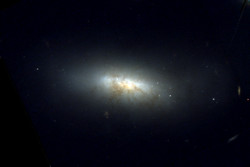Astronomy:NGC 839
From HandWiki
Short description: Galaxy in the constellation of Cetus
| {{{name}}} | |
|---|---|
 HST image of NGC 839 | |
| Observation data (J2000 epoch) | |
| Constellation | Cetus |
| Right ascension | 02h 09m 42.929s[1] |
| Declination | −10° 11′ 02.71″[1] |
| Redshift | 0.012916[2] |
| Helio radial velocity | 3847 km/s[2] |
| Distance | 174.3 ± 12.2 Mly (53.44 ± 3.75 Mpc)[1] |
| Apparent magnitude (V) | 11.42[2] |
| Apparent magnitude (B) | 13.98[2] |
| Characteristics | |
| Type | S0: pec[1] |
| Other designations | |
| MCG-02-06-034, PGC 8254[2] | |
NGC 839 is a lenticular galaxy located in the constellation Cetus. It was discovered November 28, 1785 in a sky survey by Wilhelm Herschel.[3] It is one of the galaxies that are part of the quadruplet family HGC 16, along with the unbarred lenticular galaxy NGC 838.[2]
NGC 839 is a luminous infrared galaxy (LIRG) that shows signs of high amounts of star formation; therefore, it is also classified as a starburst galaxy.[4] It is similar in appearance to Messier 82, suggesting a similar formation history.[4]
References
- ↑ 1.0 1.1 1.2 1.3 "Results for object NGC 0839 (NGC 839)". NASA/IPAC Extragalactic Database. California Institute of Technology. https://ned.ipac.caltech.edu/byname?objname=NGC%20839&hconst=67.8&omegam=0.308&omegav=0.692&wmap=4&corr_z=1. Retrieved 2021-09-08.
- ↑ 2.0 2.1 2.2 2.3 2.4 2.5 "NGC 839". SIMBAD. Centre de données astronomiques de Strasbourg. http://simbad.u-strasbg.fr/simbad/sim-basic?Ident=NGC+839.
- ↑ Seligman, Courtney. "New General Catalogue objects: NGC 800 - 849". http://cseligman.com/text/atlas/ngc8.htm#839. Retrieved 2021-09-08.
- ↑ 4.0 4.1 Rich, J. A.; Dopita, M. A.; Kewley, L. J.; Rupke, D. S. N. (2010). "NGC 839: Shocks in an M82-like Superwind". The Astrophysical Journal 721 (1): 505–517. doi:10.1088/0004-637X/721/1/505. Bibcode: 2010ApJ...721..505R.
Coordinates: ![]() 02h 09m 42.929s, −10° 11′ 02.71″
02h 09m 42.929s, −10° 11′ 02.71″
 |

